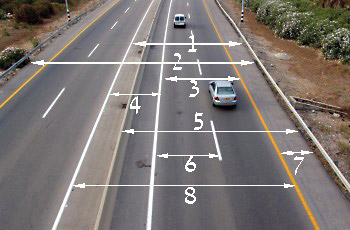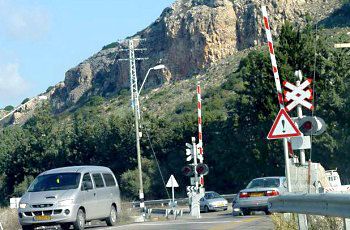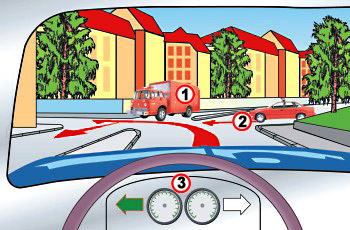Question:1
What would you do if your driving lane is obstructed?
Category : Rules and Regulations
Question:2
In an intersection without traffic lights, are you required to give right of way to vehicles coming from your opposite direction when you are about to turn left?
Category : Rules and Regulations
Question:3
To whom should a holder of a driver’s license or vehicle registration report a change of address within 15 days?
Category : Rules and Regulations
Question:4
Is it permitted to stop or park a vehicle after a pedestrian crossing?
Category : Rules and Regulations
Question:5
Is a driver obliged to show a policeman the vehicle’s original documents?
Category : Rules and Regulations
Question:6
What should you check before beginning to make a right-turn?
Category : Rules and Regulations
Question:7
What is a “work vehicle”:
Category : Rules and Regulations
Question:8
In the illustration you see a wide road. What number illustrates a hard shoulder. 103

Category : Rules and Regulations
Question:9
What must a driver do when approaching a railway crossing?

Category : Rules and Regulations
Question:10
Where should you stop your vehicle when you are obliged to stop before a railway crossing?
Category : Rules and Regulations
Question:11
What is a “commercial vehicle”:
Category : Rules and Regulations
Question:12
What is the maximum freight height permitted for a vehicle carrier that has three loading surfaces, one over the other?
Category : Rules and Regulations
Question:13
When a policeman instructs a driver to bring his vehicle for weighing – who is required to pay the weighing expenses if an irregular weight is found?
Category : Rules and Regulations
Question:14
How should drivers conduct themselves while driving opposite one another in a narrow and flat road?
Category : Rules and Regulations
Question:15
What is the legal definition of a “road”
Category : Rules and Regulations
Question:16
What is the all up length of a commercial vehicle towing a trailer?
Category : Rules and Regulations
Question:17
Is it permitted to drive a vehicle with a malfunctioning lighting system?
Category : Rules and Regulations
Question:18
What should you do when your vehicle makes unreasonable noise?
Category : Rules and Regulations
Question:19
While driving during “lighting up time” in a vehicle with an overall width of 220 cm, is it obligatory to turn-on the “Extremity“ side lights?
Category : Rules and Regulations
Question:20
What does the law state about the non-use of a vehicle for a period of more than one month?
Category : Rules and Regulations
Question:21
The length of a commercial vehicles shall not exceed:
Category : Rules and Regulations
Question:22
Is it permitted to repair a vehicle on the road?
Category : Rules and Regulations
Question:23
You are driving vehicle no. 3 before an intersection without traffic signs. According to the rules of giving right-of-way, in what order should vehicles that arrived at the same time enter the intersection?

Category : Rules and Regulations
Question:24
The use of which safety restraints is obligatory when driving children less than eight years of age?
Category : Rules and Regulations
Question:25
Can an owner of a valid driver’s license for a particular group of vehicle drive any vehicle of the same group?
Category : Rules and Regulations
Question:26
When driving behind a slow vehicle on a roadway while a continuous centre white line is marked to your left:
Category : Rules and Regulations
Question:27
Define “path”:
Category : Rules and Regulations
Question:28
What should you do when approaching a pedestrian crossing that is being crossed by pedestrians?
Category : Rules and Regulations
Question:29
When is it obligatory to operate the vehicle speed retarders?
Category : Rules and Regulations
Question:30
You are driving in the left lane of a one-way road. The driver in the right lane before you slowed down due to a pedestrian crossing the road from right to left. You are close to the pedestrian crossing, and therefore:
Category : Rules and Regulations

